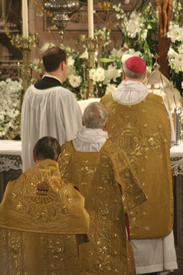The Mass: Reason for Ceremonial
NON-CATHOLIC CHRISTIANS, the Anglican Missal tells us, "have usually been suspicious of ceremonial because they are afraid that external formalities may become a substitute for worship in spirit and in truth. " Catholic worship, however, seeks to engage and present to God the whole person — And here we offer and present unto thee, O Lord, ourselves, our souls and bodies, to be a reasonable, holy, and living sacrifice unto thee. We use our whole body and "all its powers and faculties" in our worship. All of our senses are engaged, sight, hearing, smell, and touch; and at times we fall silent, hushing all of our physical facilities in attentive, centered silence. Even our brothers and sisters in the Society of Friends sit, stand, speak, and refrain from speech, following customs that are "as much a matter of ceremonial as those found in a Catholic Missal."
We seek to obey the Lord JESUS when, in instituting the Eucharist, he said "Do this." Obedience to that divine command would be impossible without the actions that have come to be known as Catholic ceremonial. As the Missal correctly observes, "The question is not whether we are to have ceremonial, but what kind of ceremonial we are to use." Our ceremony, with its stylized movements, gestures, elaborate courtesies, and poetic liturgical language, is designed to intensify all that we do in obedience to the Lord's command.
The norm for our ceremonial is the High Mass as it has developed over the centuries. At the Mass, we offer to God the best we can. Thus, our sacred ministers use traditional vestments that signal the gravity and joy of the Eucharist; our musicians offer the best of the Church's musicianship; the language of the liturgy is stately, poetic, and memorable. We offer this entire ensemble of prayer—our words, the gestures of our bodies, and the song of our hearts—to the one triune God amid columns of sweet-smelling smoke, following the holy tradition of uncounted saints who have preceded us and who rejoice with us "on another shore and in a greater light.".
For an additional discussion of the ceremonial of High Mass, see the Anglican Missal, which is the source for the foregoing discussion. For a rich, uninhibited commentary on the ceremonial of the Mass, click here to read Fr. Richard Major's Freeze-Frame Mass.

